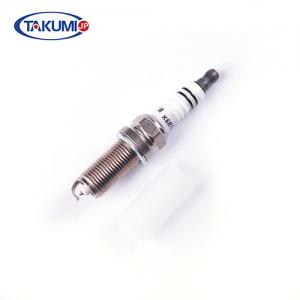

Add to Cart
AUTO SPARK PLUG DR12YC BCPR7E BCPR7ES BKR7E FR7DC CAR CANDLE
| Brand | Model |
| AC Delco | CFR1CLS |
| AC Delco | FR1LS |
| Autolite | 3922 |
| Autolite | XS3922 |
| Beck Arnley | 176-5206 |
| Beru | 0002345702 |
| Beru | 14F-5DU |
| Beru | 14FR-5DU |
| Beru | 14FR5DU |
| Beru | 2345702 |
| Beru | UXT5 |
| Beru | Z 30 |
| Beru | Z 30 |
| Beru | Z30 |
| Bosch | 0 242 245 515 |
| Bosch | 0 242 245 536 |
| Bosch | 0242245515 |
| Bosch | 0242245536 |
| Bosch | F5DC |
| Bosch | FR5DC |
| Bosch | FR5DC+ |
| Bosch | FR5DP |
| Brisk | DR12YC |
| Brisk | DR14YC |
| Champion | OE014 |
| Champion | OE014/R04 |
| Champion | OE014/T10 |
| Champion | OE043 |
| Champion | OE043/R04 |
| Champion | OE043/T10 |
| Champion | OE094 |
| Champion | OE110 |
| Champion | OE110/T10 |
| Champion | RC6YC |
| Champion | RC6YCC |
| Champion | RC7Y |
| Champion | RC7YC |
| Champion | RC7YCC |
| Champion | RC9YC |
| Champion stk | 344 |
| Denso | 3010 |
| Denso | 3347 |
| Denso | 5313 |
| Denso | D23 |
| Denso | IQ22 |
| Denso | Q22PR-U |
| Denso | Q22PRU |
| Denso | VQ22 |
| Denso stk | 3010 |
| Enker | SFE85CP |
| Eyquem | RFC62LS |
| Eyquem | RFC82LS |
| Fiat | 5894588 |
| Fiat | 7760384 |
| Fiat | 7GYSSR |
| Iskra | SFE85CPR |
| Iskra | SFE85PRS |
| Lodge | 2HLDR |
| Magneti Marelli | 061830072304 |
| Magneti Marelli | 8LCR |
| Magneti Marelli | 8LPR |
| Magneti Marelli | CW8LCR |
| Magneti Marelli | L8LCR |
| Motorcraft | AGPR12C |
| Motorcraft | AGPS12C |
| NGK stk | 3330 |
| Nissan | 12E17 |
| Nissan | 22401-12E17 |
| PAL (Brisk) | DR14YC |
| Peugeot | 5962.K1 |
| Peugeot | 5962.KO |
| Peugeot | 5962.V8 |
| Peugeot | 5962.W6 |
| Peugeot | 5962.W7 |
| PSA Peugeot Citroën | 5962K1 |
| PSA Peugeot Citroën | 5962KO |
| PSA Peugeot Citroën | 5962V8 |
| PSA Peugeot Citroën | 5962W6 |
| PSA Peugeot Citroën | 5962W7 |
| Splitfire | SF392B |
| Unipart | GSP2023 |
| Unipart | GSP4652 |
| Unipart | GSP6652 |
| Unipart | GSP684 |
Features
1 . Iridium power best demonstrates its performance improvement during acceleration
2 . Iridium center electrode and a specially shaped ground electrode.
3 . High-respons e driving with fewer misfires than under higher required voltage spark conditions,
and fewer misfires when ignitability is difficult.
4 . Outstanding acceleration, high fuel efficiency and durability.
5 . Corrugated Ribs Prevent Flashover.
Q1 What is the heat rating of a spark plug?
A spark plug must dissipate the heat produced by the combustion
gases. The heat rating is a measure of the amount of heat
dissipation.
It is essential to use a spark plug with a heat rating that matches
a specific engine and its condition of use.
When a wrong heat rating is selected,
When the heat rating is too high,
The spark plug temperature remains too low and causes deposits to
build up on the firing end; the deposits provide an electrical
leakage path that possibly cause misfire.
When the heat rating is too low,
The spark plug temperature rises too high and induces abnormal
combustion (pre-ignition); this leads to melting of the spark plug
electrodes that could cause problems such as piston damage.
Q2 How long will a spark plug last?
A Even when a spark plug is correctly used, periodic replacement is
required as it is a consumable item.
Examples of problems caused by excessively long periods of use:
Worn-out electrodes will have difficulty in sparking.
Deposits accumulated on the firing end may induce abnormal
combustion, causing problems that include melting of the electrodes
or damaging engine.
These spark plugs require replacement.
It must be noted that these phenomena may also be caused by
inadequate engine servicing (fuel systems and ignition system) and
incorrect spark plug selection.
Q3 In addition to correct heat rating, what other precautions
should be taken during installation of spark plugs?
A Ensure the spark plug has the correct thread reach.
The engine will not operate properly without the proper thread
reach.
If a spark plug with the wrong thread length is erroneously used,
the piston or valve could strike it and damage the engine.
Moreover, there is also the concern that the electrode could
overheat and melt.
A Ensure the spark plug has the correct projection dimensions.
There are several types of spark plug igniter shapes.
Sometimes, even when the length of the thread is correct,
installing a spark plug with long metal shell projection dimensions
may cause it to be struck by the piston or valve and result in
engine trouble. Only use projection type plugs as specified by the
manufacturer.
When trying to remove a spark plug that is tight and will not come
out easily, removing it by force may damage the neck of the
threaded section and break the seal section of the spark plug,
causing the threaded section to remain in the cylinder head.
To remove such a spark plug without excessive force, first operate
the engine and allow it to warm up the cylinder head, then apply
penetrating oil to the threaded section.
After a short while, the spark plug can be removed.
